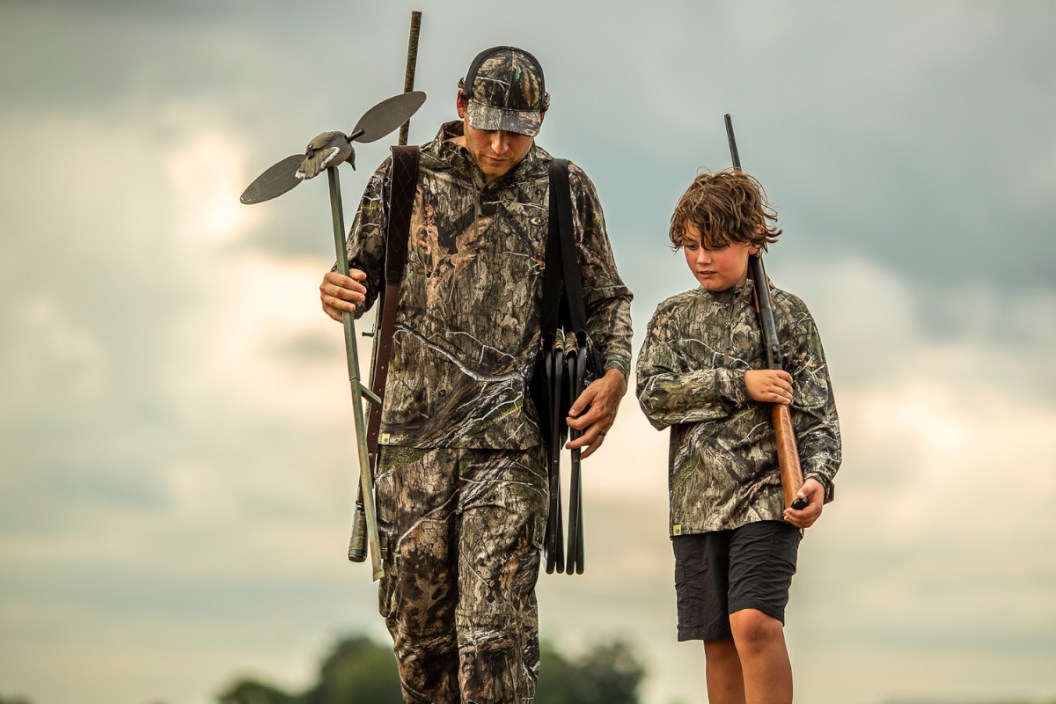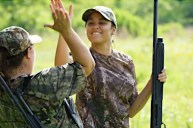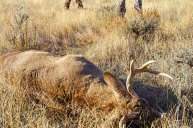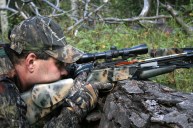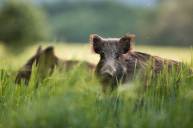Make hunting easier for newbies with these tips.
Make no mistake, hunting is one of the most difficult pastimes for someone to take up. The tradition has one of the biggest learning curves of all outdoor activities. Especially when it comes to something like bow hunting for big game animals. As a result, many new hunters can feel overwhelmed and intimidated.
After all, there are tons of things to learn, from how to spot and stalk, hunter safety, hunting regulations, how to scout, and the processes for skinning and dressing game animals once they are finally on the ground.
To make for an easier time learning and better hunting experiences overall, we have some tips and ideas to reduce that huge learning curve. Most of these tips are designed to help experienced hunters in their mentoring of newbies, but if you are a new do-it-yourself hunter, you can still probably pick up a lot of practical tips to make your first hunting season a great one.
Take an in-person hunter education course.
Here in North America, every state and Canadian province requires hunters to take some sort of safety course before they are allowed to purchase a hunting license these days. Many states have made things easier for prospective hunters by making hunter safety an online course. Most of these courses require a field day with time at a shooting range and practical demonstrations on stuff like tree stand safety and even how to follow a blood trail. Some states have made it so you can complete all your hunter education completely online. While this may be convenient, it is not ideal for a green rookie coming in with zero hunting experiences.
Because an in-person course will often have longer discussions and demonstrations on how to use different types of hunting gear and what you will need for turkey hunting vs what you will need for whitetail deer. They might take new hunters out into the field to show new deer hunters the difference between scrapes and rubs, or how to field judge the antlers of a deer to make sure it is legal.
More importantly, an in-person course gives the chance for questions and answers. New hunters can get practical tips on things like archery or muzzleloader gear, or they can ask about things like steel shot vs lead shot and where each is legal to use.
Perhaps the most valuable aspect of an in-person course is one-on-one range time. A good instruction can help you with your form with a bow or gun. They will go over the intricacies of firearms safety in a manner that is easier to understand than a textbook. They will also help to alleviate some of the fears a new hunter may have about firearms, especially if they have never used one before. Simply put, the value of classroom experience is much greater when you are in the same room as your instructors.
Start small and action-packed.
While some newbies can dive right into deer and elk hunting and be good at it, building basic skills and hunter safety is probably best reserved for a small game or bird hunting experience. The attention of young hunters is more easily kept when they are seeing lots of action upland bird or waterfowl hunting than it is waiting for hours in a blind or treestand while deer hunting.
If you are mentoring a hunter, taking them on a hunt for smaller game really gives a chance to hone the basics of things like keeping the firearm pointed in a safe direction and knowing what is beyond your target.
Another plus is this type of hunt usually gives more leeway for a newer hunter to mess up than big game hunting. You can miss a bunch of shots all morning and still have success in the afternoon. Also, finding success in a small game or bird hunt is not nearly as intimidating as downing a deer. Most of these smaller game animals are quick and easy to field dress and will help a newbie prepare for what is involved with a larger animal.
Focus on basic gear first.
Newer hunters can quickly become intimidated walking into a sporting goods store and seeing endless racks of camo, and shelves filled with all sorts of deer hunting scents and gadgets. However, it helps to emphasize to newbies that you do not need a $2,000 crossbow, or a $400 jacket to find success hunting. The great thing about hunting is it can be done on any budget. For newbies it is best to emphasize what is going to be warmest, and what will stand up to the elements best over any sort of camo pattern. On that same note, a good pair of boots goes a long way to making the experience more comfortable, allowing the newbie to spend more time afield. The more time afield, the more the learning curve is lessened.
Instead of diving head-first into all the advanced scent control options out there, focus on hunting the wind first. Sure, scent control products help, but they are not a necessity for a successful hunt. Get the basics of avoiding detection down pat first and then you can worry about trying different products to make it easier. The same goes for all the calls and scents so often marketed for use during the rut. Unless you are hunting waterfowl or turkeys where calls and decoys are a must, learning to hunt without these products first and learning the basic habits of animals will prove far more valuable than trying to use them your first hunting trip out.
If you are helping a newbie pick up their first firearm, go for practicality and multiple uses. Shotguns like the Remington 870 and Mossberg 500 often sell "field combos" with a barrel for shooting slugs at big game and another barrel for turkeys and upland game so they have something they can use in all seasons.
Newer hunters are likely to get much more use out of a good pair of gloves and a hat than they will the countless hunter gimmick products on the market. If you are mentoring a new hunter, a trip to the store with your newbie can help them to recognize quality and avoid the pitfalls of products that are designed to appeal to hunters more than animals. For new DIY-style hunters, remember that people have hunted successfully for hundreds of years without the modern gadgets and gear of today. This stuff can greatly enhance your hunt, but it is not always necessary.
Watch and learn.
In the past, hunting trips were always intimidating for a newbie because it was hard to know what to expect if you have never been out before. Today the Internet is home to literally thousands of hours of video of people hunting from which to observe and learn. Of course, not all YouTube channels are created equal, and not all shows emphasize what hunting is all about. There are still some content producers out there who make great shows that are ideal learning opportunities for new hunters.
One I can name right off the bat is The Hunting Public on YouTube. Most of their content is filmed in public hunting areas, although they do venture to private land sometimes too. Either way, their content is perfect turkey and deer hunting 101. They also show you do not always need the latest and greatest gear to get the job done. See the video above.
Another show I like for the realistic portrayal of hunting is Steven Rinella and his show "Meateater." The great thing about his show is he takes the time to show the butchering process and meal preparation after the hunt, which not every major hunting personality takes the time to do.
The reason I single out those two shows is because these are hunters who are not afraid to show how much hard work it is to hunt. They show the good right along with the bad and it helps to set realistic and reasonable expectations for a new hunter. Plus, there are some dynamite deer hunting tips in most episodes that will help even the most seasoned of hunters.
Finding the good shows takes a lot of trial and error, but there is a ton of information to be gleaned from the web in video form that will help mentally prep a new hunter for what to expect the first time they enter the woods. It's a resource I wish had been available when I started hunting.
Accompany a hunter into the woods before you go afield.
Perhaps the best way to reduce the learning curve for new hunters is for them to go into the field with an experienced hunter before ever trying it for themselves. There is no better way to learn the basics of hunting than by watching an experienced hunter in the field. It helps the newbie understand exactly what hunting is about.
This is probably the best way to mentor someone new in the hobby because it gives newbies the chance to learn things like spotting and stalking game without the additional pressure of trying to harvest it. It allows them to experience the different weather conditions and test their gear before applying it to a real hunting scenario.
Most importantly, with a good mentor, it provides the chance for the new hunter to come up with and get answers to questions they may not have even thought about. Newer hunters who have been in the field prior to toting a gun or bow afield for the first time are also more likely to set reasonable expectations for their first hunt. They will likely be a little more patient and less likely to get upset if they end up not harvesting anything.
The learning curve for hunting may be steeper than most hobbies in the outdoors, but a little common sense and thorough preparation can go a long way towards making the experience more pleasant for a newer hunter. It will also make it more likely the newbie will enjoy and stick with their new passion in the long run.
Products featured on Wide Open Spaces are independently selected by our editors. However, when you buy something through our links, we may earn a commission.
For more outdoor content from Travis Smola, be sure to follow him on Twitter and check out his Geocaching and Outdoors with Travis YouTube channels.
NEXT: THE AXIS DEER AND HOW THEY'RE IMPACTING PARTS OF THE UNITED STATES
WATCH
